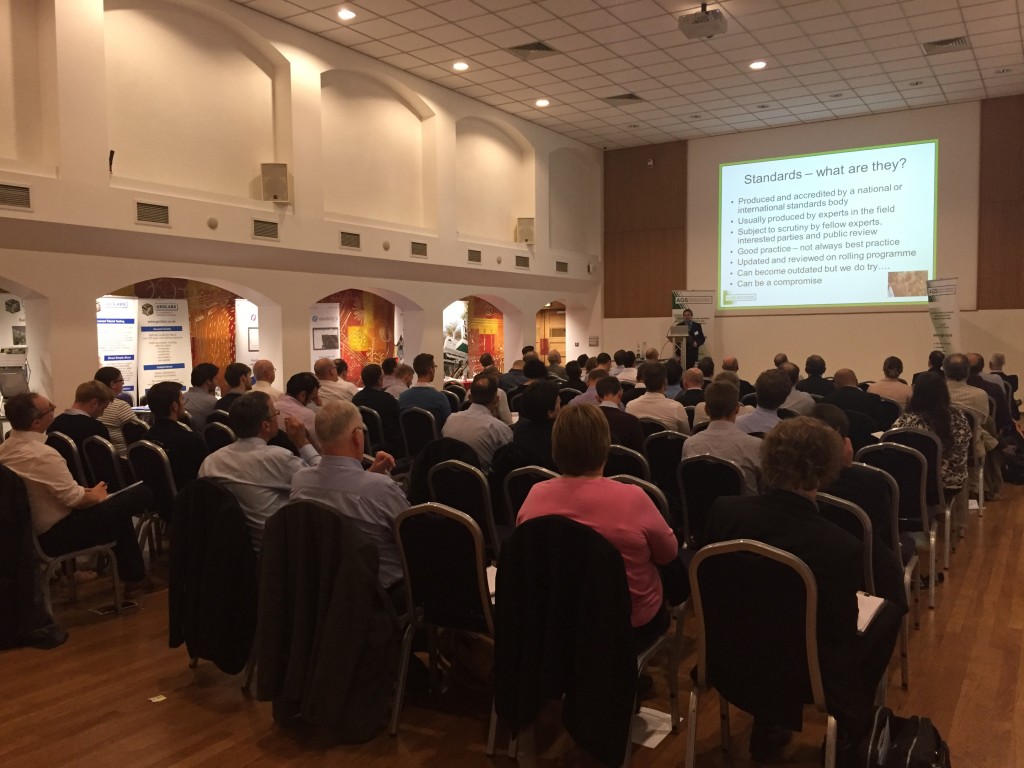Article written by Julian Lovell, Chair of the AGS Safety Working Group and Managing Director of Equipe.
Over the last 6 years, Geotechnica has become the biggest and best geotechnically-dedicated conference and exhibition that the UK has to offer. From humble beginnings in marquees in a field on The Upton Estate in rural Oxfordshire, to the excellent purpose-built facilities of the Warwickshire Exhibition Centre, Geotechnica has become a staple in any and all geotechnical stakeholder’s calendars.
In this issue of theGeotechnica, we look forward to this year’s Geotechnica and outline exactly why you should be attending 2015’s event. Whether it is to attend the always excellently received geotechnical conference featuring speakers from high profile clients such as HS2 Ltd and Network Rail; discover the latest product developments and innovations; meet prospective clients, contractors and suppliers, or to catch up with friends new and old – Geotechnica offers something for everyone.
Growth in the sector – tackling the challenges
The Geotechnica 2015 conference and exhibition provides a unique opportunity for the geotechnical industry, its clients and the supply chain, to discuss how best to meet the challenges of the UK construction’s growing order book.
The dramatic rise in UK infrastructure and building projects following the recession has created skills shortages across the construction industry. For the geotechnical sector, this upturn in work presents significant challenges. High Speed 2, for example, is set to swallow almost 40% of the sector’s capacity when ground investigations start later this year.
The urgent need to tackle the issues of capacity and skills, while maintaining quality and safety standards, will be the focus of Geotechnica 2015. On the first morning of the event the conference will bring clients, consultants, contractors, suppliers and manufacturers together to discuss how best to meet the challenges ahead.
The morning session will be chaired by Professor David Norbury who will provide critical information of the soon to be published BS 5930 revision. Jonathan Gammon, High Speed 2’s Head of Ground Investigations, and Mike Brown from Network Rail, will then outline work plans, plus their needs and expectations. The talks will not only outline current requirements but the Client’s will also discuss future requirements and aspirations and ask how the Community can meet these.
Remote monitoring advances
The Wednesday afternoon at the geotechnical conference will see a series of presentations looking at how the field instrumentation is advancing and how emerging technologies can be used to efficiently monitor geotechnical structures remotely. The session will look at a few of these technologies but also discuss how the data can be used more efficiently and possibly in the future be shared with the Community.
Talks from Dr Andrew Ridley of Geotechnical Observations and Professor Neil Dixon of Loughborough University will head up the session, with case studies and technical discussions from Dr David Gunn and Dr Jonathan Chambers of the BGS. Short presentations from Martin Clegg of Geosense, Heba Bevan of Utterberry, James Preston of Monitoring Optics and Roger Hazelden of TRW Conekt will round up the day’s talks with insights into the emerging technologies which are likely to take the industry by storm.
Health and Safety Updates
Over the last 12 months, we have all been discussing forthcoming changes to the Construction Design and Management Regulations. These have now been laid before parliament and came into effect on the 6th of April earlier in the year. On the Thursday morning of the conference there will also be a session sponsored by the British Drilling Association on health and safety, with discussions on changes brought about by the new CDM 2015 Regulations lead by John Underwood, Construction Inspector at the Health and Safety Executive.
The CDM 2015 regulations have been discussed at length in theGeotechnica in the last few issues, however Geotechnica 2015 will provide an opportunity for contractors to hear directly from the HSE on how these new regulations will directly affect day-to-day tasks on working sites.
Other topics discussed on the Thursday morning include the rising issue of asbestos in soil (also covered in Issue 40 of the magazine by Derwentside Environmental Testing Services’ Hazel Davidson), with a presentation from expert Seamus Lefroy-Brooks, Managing Director of LBH Wembley.
Finally there is the exciting news of the re-launch of the BDA Audit which has recently been revised in order to improve levels of assessment and competency which will complement the launch of a Level III NVQ for Land Drilling planned later this year. Delivering this update will be Peter Redford who is a director of BDA and chaired the working group which carried out the review of the auditing process. He will present these changes to attendees at Geotechnica 2015, outlining the changes to non-conformance, an updated and digitised audit format and alteration of base-rate auditing fees.
AGS Data efficiencies
The final conference session is sponsored by AGS and will be focussed on digital (AGS) data and how it can help to make organisations more efficient. The afternoon of presentations and discussions offers engineers and clients an opportunity to learn how others are using digital data and the AGS Data Format for managing geotechnical information within their organisations. The session will consist of a series of inspirational and practical presentations with plenty of discussion time that will help you make better use of the AGS Data Format.
Whether you are; an experienced user of AGS Data, someone wanting to learn more about using or specifying AGS Data, or an early-career engineer looking for an introduction to data management, this afternoon will provide you with a valuable learning opportunity.
Speakers in this session include Chairman of the AGS Data Management Working Group Jackie Bland, General Manager of Ground Technology Services Ben Armstrong, Simon Miles of Atkins, and also Dr Roger Chandler, Managing Director of Keynetix.
Each 30 minute session consists of a 15 minute practical application presentation by the speaker(s) followed by a panel and audience discussion about the topics with advice from the AGS Data Management Committee and other practitioners.
This session is a must for any handlers of AGS Data, and also for anyone wishing to gain a greater grasp of what AGS Data can offer you in terms of improving your organisations efficiency from site to final report.
Latest product innovations – demonstrations and launches
One way the geotechnical sector can meet the increasingly growing demand is by improving efficiency through innovation, a theme running through the two days at Geotechnica, both at the conference and also at the exhibition. Conference sessions on advances in digital data capture and remote monitoring on the Wednesday afternoon will be complemented by product launches and live demonstrations in the exhibition area running throughout both days of the event.
New product launches are due from a number of companies including two large rig manufacturers. Firstly Geotechnica 2015’s Gold Sponsors Casagrande UK will be launching the new C5XP, as well as a new vibro-rotary head by Eurodrill. Not to miss out on the rig launch party, Rockbit UK will be launching the new Massenza MI 3 and a new Wildbore De-sander unit and EK bag system, as well as demonstrating the Pagani CPTu penetrometer throughout both days on request. The Equipe Group will also be officially launching there SAFER-G Sensor-based rotary rig guarding system to the UK market, as well as a new KeyLogbook update release.
The laboratories present at Geotechnica will also be getting in on the act, with Derwentside Environmental Testing Services introducing there new asbestos in soil test – the fibre release test. ALS Environmental will also be demonstrating some of their OnSite tools including XRF, UVF and PetroFLAG.
The Geotechnical Academy
The Geotechnical Academy will again be at Geotechnica to demonstrate how it provides a unique learning experience for young geo-professionals. The training is designed to be fundamentally vocational, with many opportunities throughout the modules to participate in practical activities such as rig audits, insitu testing, laboratory testing, site visits and production of a ground model. An important aspect of The Geotechnical Academy is to allow delegates to gain knowledge through a shared learning experience with delegates from different facets of the geotechnical industry. We frequently bring together main contractors, specialist contractors and geo-environmental and geotechnical consultants, all with very different experiences of the industry.
This year at Geotechnica, The Geotechnical Academy stand will perform the traditional service of providing information. Academy staff will be there to discuss module content and practical activities and to welcome new enquiries. However, in addition we will also be presenting the new Geotechnical Academy Conference on Thursday 9th July. This will be an afternoon conference session offering an innovative learning experience for all geo-professionals as well as providing an opportunity to experience first-hand the type of experience delegates can expect if they attend The Geotechnical Academy. The event is being supported by Alcontrol, Lankelma, Keynetix, Equipe and Geotechnical Engineering Ltd who, along with other companies, all contribute to individual Academy modules throughout the year.
Come along and experience The Geotechnical Academy Conference on Thursday 9th July and contribute to enabling your geo-professionals to provide a quality service to the construction industry.
Packed exhibition line-up
The exhibition line-up for this year’s event is stellar. Geotechnica has always boasted the most varied and robust line-up of exhibitors in the UK, however the offering in 2015 may be the best yet. Companies from all areas and corners of the industry will be represented, with the very best in geophysics, ground investigation specialists, civil engineering, environmental and geotechnical laboratories, drilling rig, plant and equipment suppliers, instrumentation and geothermal specialists all out to impress the hundreds of attendees.
Geotechnica 2015 will be held on 8th and 9th July at the Warwickshire Exhibition Centre, Royal Leamington Spa. To register for your free place and for more information, visit www.geotechnica.co.uk; follow us on Twitter @equipegroup and visit the Equipe Group LinkedIn page.



